Richard Williams has written about music for the Melody Maker, the Times, the Independent on Sunday, the Guardian, Down Beat, Jazz Journal, Mojo, the TLS, Granta, Uncut and other publications. He is a former editor of Time Out, was the original presenter of The Old Grey Whistle Test and served a three-year term as artistic director of the Berlin jazz festival from 2015-2017. He has interviewed everyone from John Lennon and Brian Wilson to Marvin Gaye and Curtis Mayfield to Miles Davis and Chet Baker. He also happens to live about a mile down the road from me, so I hoped he might be interested in my book Raving Upon Thames: An Untold Story of Sixties London. I could not have hoped for a better and more generous response than the write-up he gave it on his superb blog, The Blue Moment:
Around the corner from where I live is an apartment that was once a crash-pad for Paul Simon, Jackson C. Frank and John Martyn. If I carry on to the train station, I pass the building where the Rolling Stones played the early gigs that attracted the attention of Andrew Loog Oldham and the four Beatles. On the way I see another building, now a Nando’s, where Eric Clapton and his fellow art students would while away an afternoon over a single cup of coffee. A couple of doors above it is the site of a clothes shop that was once vital to the Mod culture. I walk on past an independent book shop which, 50-odd years ago, was owned by Pete Townshend (who still lives a few hundred yards away, up the hill, past the house where Syd Barrett once had a flat). Beyond the station lies a rugby ground, the site of the festivals that, starting in 1961, created the enduring pattern for such open-air, multi-stage events.
If, instead of heading for the station, I were to walk in the opposite direction, I’d come to the footbridge to an island where, as the ’60s picked up speed, trad jazz gave way to R&B bands in a semi-derelict hotel whose ballroom featured the Cyril Davies All Stars, Long John Baldry’s Hoochie Coochie Men with Rod Stewart, the Yardbirds, John Mayall’s Bluesbreakers, the Downliners Sect, the Art Woods, the Graham Bond Organisation, and so on.
The place that featured the Stones was the Station Hotel in Richmond, where the back room hosted the first incarnation of the Crawdaddy Club. The coffee bar was called L’Auberge. The men’s boutique was John Simon’s Ivy Shop. Townshend’s book shop was called Magic Bus. The rugby ground is the home of Richmond RFC and London Scottish; their clubhouse became the second Crawdaddy, where the Yardbirds — mostly local boys — took flight. The Eel Pie Island Hotel is the legendary venue in the middle of the Thames at Twickenham, which opened with local trad jazz bands in 1956, closed in 1970 with Quintessence and burned down while being demolished the following year. Those are some of the locations, and there are many more, including the Hanging Lamp folk club, held in a church crypt, where the local teenager who would become Elvis Costello went to listen to guitarists like Davey Johnstone and John James.
The story of how Richmond and Twickenham — and particularly Eel Pie Island — became a seed-bed for the British R&B bands that, in conjunction with the Mersey Beat, reset the course of rock music is such a great one that I’ve often thought it was worth a proper book, particularly after I came to live here 20 years ago and realised that the buildings and the pavements had tales to tell. I never got around to it. But now someone else has, and he’s done it so well that I’m glad I didn’t.

